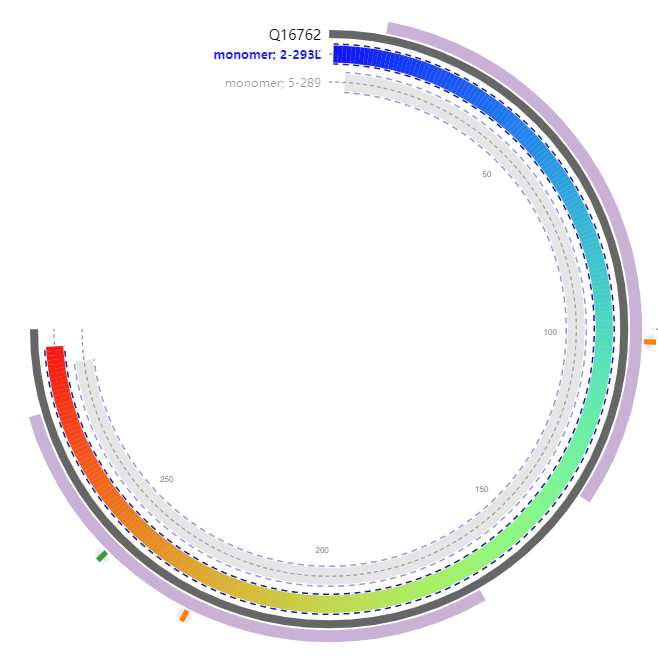Formation of iron-sulfur complexes, cyanide detoxification or modification of sulfur-containing enzymes. hydrogen cyanide + thiosulfate = 2 H+ + sulfite + thiocyanate
MVHQVLYRALVSTKWLAESIRTGKLGPGLRVLDASWYSPGTREARKEYLERHVPGASFFD
IEECRDTASPYEMMLPSEAGFAEYVGRLGISNHTHVVVYDGEHLGSFYAPRVWWMFRVFG
HRTVSVLNGGFRNWLKEGHPVTSEPSRPEPAVFKATLDRSLLKTYEQVLENLESKRFQLV
DSRSQGRFLGTEPEPDAVGLDSGHIRGAVNMPFMDFLTEDGFEKGPEELRALFQTKKVDL
SQPLIATCRKGVTACHVALAAYLCGKPDVAVYDGSWSEWFRRAPPESRVSQGKSEKA
302

| PMID | Title & Author | Abstract | Year | |
| 0 | 19145231 | Ubiquitin-related modifier Urm1 acts as a sulphur carrier in thiolation of eukaryotic transfer RNA.Leidel S, Pedrioli PG, Bucher T, Brost R, Costanzo M, Schmidt A, Aebersold R, Boone C, Hofmann K, Peter M | Ubiquitin-like proteins (UBLs) can change protein function, localization or turnover by covalent attachment to lysine residues. Although UBLs achieve this conjugation through an intricate enzymatic cascade, their bacterial counterparts MoaD and ThiS function as sulphur carrier proteins. Here we show that Urm1p, the most ancient UBL, acts as a sulphur carrier in the process of eukaryotic transfer RNA (tRNA) modification, providing a possible evolutionary link between UBL and sulphur transfer. Moreover, we identify Uba4p, Ncs2p, Ncs6p and Yor251cp as components of this conserved pathway. Using in vitro assays, we show that Ncs6p binds to tRNA, whereas Uba4p first adenylates and then directly transfers sulphur onto Urm1p. Finally, functional analysis reveals that the thiolation function of Urm1p is critical to regulate cellular responses to nutrient starvation and oxidative stress conditions, most likely by increasing translation fidelity. | 2009 |
| 1 | 23929717 | Dose and time-dependent effects of cyanide on thiosulfate sulfurtransferase, 3-mercaptopyruvate sulfurtransferase, and cystathionine λ-lyase activities.Poonam Singh , Pooja Rao, Rahul Bhattacharya | We assessed the dose-dependent effect of potassium cyanide (KCN) on thiosulfate sulfurtransferase (TST), 3-mercaptopyruvate sulfurtransferase (3-MPST), and cystathionine λ-lyase (CST) activities in mice. The time-dependent effect of 0.5 LD50 KCN on cyanide level and cytochrome c oxidase (CCO), TST, 3-MPST, and CST activities was also examined. Furthermore, TST, 3-MPST, and CST activities were measured in stored mice cadavers. Hepatic and renal TST activity increased by 0.5 LD50 KCN but diminished by ≥2.0 LD50. After 0.5 LD50 KCN, the elevated hepatic cyanide level was accompanied by increased TST, 3-MPST, and CST activities, and CCO inhibition. Elevated renal cyanide level was only accompanied by increased 3-MPST activity. No appreciable change in enzyme activities was observed in mice cadavers. The study concludes that high doses of cyanide exert saturating effects on its detoxification enzymes, indicating their exogenous use during cyanide poisoning. Also, these enzymes are not reliable markers of cyanide poisoning in autopsied samples. | 2013 |
| 2 | 15805776 | Identification of putative sulfurtransferase genes in the extremophilic Acidithiobacillus ferrooxidans ATCC 23270 genome: structural and functional characterization of the proteins.Mauricio Acosta , Simon Beard, Jose Ponce, Mario Vera, Juan C Mobarec, Carlos A Jerez | Eight nucleotide sequences containing a single rhodanese domain were found in the Acidithiobacillus ferrooxidans ATCC 23270 genome: p11, p14, p14.3, p15, p16, p16.2, p21, and p28. Amino acids sequence comparisons allowed us to identify the potentially catalytic Cys residues and other highly conserved rhodanese family features in all eight proteins. The genomic contexts of some of the rhodanese-like genes and the determination of their expression at the mRNA level by using macroarrays suggested their implication in sulfur oxidation and metabolism, formation of Fe-S clusters or detoxification mechanisms. Several of the putative rhodanese genes were successfully isolated, cloned and overexpressed in E. coli and their thiosulfate:cyanide sulfurtransferase (TST) and 3-mercaptopyruvate/cyanide sulfurtransferase (MST) activities were determined. Based on their sulfurtransferase activities and on structural comparisons of catalytic sites and electrostatic potentials between homology- modeled A. ferrooxidans rhodaneses and the reported crystal structures of E. coli GlpE (TST) and SseA (MST) proteins, two of the rhodanese-like proteins (P15 and P16.2) could clearly be defined as TSTs, and P14 and P16 could possibly correspond to MSTs. Nevertheless, several of the eight A. ferrooxidans rhodanese-like proteins may have some different functional activities yet to be discovered. | 2005 |
Nakamura T , Yamaguchi Y , Sano H . Plant mercaptopyruvate sulfurtransferases[J]. European Journal of Biochemistry, 2003, 267(17):5621-5630.